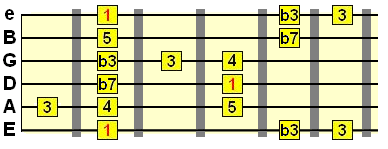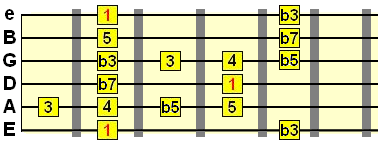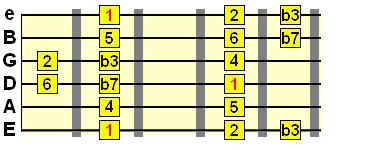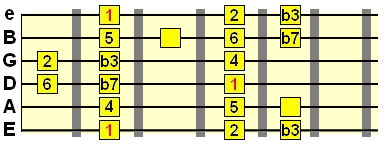Home
> Scales
> Scale
Phrasing 2
We navigated the scale from a safe starting note to a safe destination note which helped put our phrases into context. These safe/resting tones were based around the major or minor triads, depending on which scale we were using and the backing chord.
Video Lesson
Now we're going to look at how to add a bit more colour to our scale phrases by adding in chromatic phrases and passing tones. In a nutshell, these are tones that lie both inside and outside the scale we're using in the solo and the backing chord.
As a result, some of these "outside" tones would sound dissonant if emphasised (e.g. held as a destination tone) in our solo. What makes them sound good is when they're used to resolve up or down to a safer, scale/chord tone. So we resolve quickly from dissonance to harmony.
For example, take the Mixolydian scale over a dominant 7th chord (e.g. C Mixolydian over C7). In the below table, the intervals in the right hand column are a natural part of the scale and the implied chord. The intervals in the left hand column are "outside" the scale and would therefore create dissonance against the chord.

An example of this dissonance > resolution concept would be the minor 6th (♭6) resolving down to the 5th (5) or up to the major 6th (6) of the scale. If included as part of a phrase, the ♭6 would be considered a passing tone because holding on to or emphasising it too much would create dissonance against the dominant 7th backing chord - Mixolydian's natural chord type.
The ♭6 passing tone could be used in a chromatic phrase such as:
Or the major 7th in the following, like a chromatic bridge between the ♭7 and 1 of the scale/chord:
Let's start with what is probably the most recognisable use of chromatics in major key blues licks - resolving the minor 3rd to the major 3rd over the tonic (I/1) chord (that's the first chord in a typical blues progression).
So if we had a blues progression in A major, the safe starting and destination notes for our phrases on that root A major chord would be based on the major triad (1 3 5 / A C♯ E). But in blues it's common to mix minor and major pentatonics...

Here we have a major 3rd added to minor pentatonic which we can use as an effective destination note in our major key blues phrasing. The minor 3rd (♭3) therefore becomes an "outside" or passing tone which we can use to quickly resolve to the major 3rd. Remember we're in the key of A major for these examples...
1 - ♭7 - ♭3 - 3 - Hear example
To make the resolution smoother, I hammer-on from the minor 3rd to major 3rd.
We can also add in the 4th, another passing tone over major chords, although this time it's inside the scale, to enhance this resolution effect...
♭7 - 5 - 4 - ♭3 - 3 - Hear example
So the key thing here is not to dwell on these passing tones, but using them before a quick resolution to a more stable tone is a very nice way of spicing up your licks.
Also common as part of pentatonic licks is the use of the flat 5th (♭5) or "blue note", which is also a chromatic, passing tone that tends to be resolved quickly, either up to the 5th or down to the 4th...

5 - ♭5 - 4 - ♭3 - 3 - Hear example
Remember, we can resolve to either the root, 3rd or 5th as they are safe triad tones. We could also resolve to the flat 7th as this is a natural extension of the major triad used in blues.
It also works as part of an extended, unresolved sequence of tones like below, but because we have those stable starting and destination notes, the chromatic tones blur into the context of the larger phrase...
♭7 - 5 - ♭5 - 4 - ♭3 - 1 - 4 - ♭3 - 3 - Hear example
There you can see a sequence of 4 chromatic tones broken up by the root (1) and resolving to the major 3rd (3).
So what would otherwise be quite jarring, dissonant tones over our major backing chord, suddenly become a natural part of the flow of our phrase. This is why it was so crucial for you to learn about starting and destination notes in part 1!

Technically, we could fill any of the interval gaps with chromatic, passing tones, but there are a couple that work particularly well. You should experiment to find what sounds good as I can't cover every scale, unfortunately!
The first example is to add a chromatic ♯5/♭6 between the 5 and 6 tones as follows...

Using this, we can try and work it in to some Dorian based phrases over a minor 7th chord (in this example Am7). Remember, these chromatic tones work well as long as you embed them in a larger phrase between two safe tones, e.g. the minor triad (1 3 5)...
1 - ♭7 - ♭6 - 6 - ♭3 - Hear example
In that example, I used a double slide from the ♭6 to the 6 to slur (smooth out) this resolution.
Or, we could pass straight through the chromatic ♭6 tone in a linear sequence as follows...
♭3 - 1 - 2 - ♭7 - 1 - 6 - ♭7 - 6 - ♭6 - 5 - 4 - ♭3 - 2 - Hear example
Try your own chromatic phrases based on the scales you know, filling in those interval gaps. If you're confident with the concept of resolution and safe landing notes, you should be able to make most chromatic movements sound natural and effective as part of your solos.
Try resolving the chromatic tones up and down. Try including them as part of a quick succession of passing tones before landing on a safe tone from the scale. I hope this lesson gave you some inspiration to explore your own chromatic licks!
More Guitar Scales Lessons
Scale Phrasing - Chromaticism & Passing Tones
In the first scale phrasing lesson, we learned how to create simple but musical lead passages through our scales.We navigated the scale from a safe starting note to a safe destination note which helped put our phrases into context. These safe/resting tones were based around the major or minor triads, depending on which scale we were using and the backing chord.
Video Lesson
Now we're going to look at how to add a bit more colour to our scale phrases by adding in chromatic phrases and passing tones. In a nutshell, these are tones that lie both inside and outside the scale we're using in the solo and the backing chord.
As a result, some of these "outside" tones would sound dissonant if emphasised (e.g. held as a destination tone) in our solo. What makes them sound good is when they're used to resolve up or down to a safer, scale/chord tone. So we resolve quickly from dissonance to harmony.
For example, take the Mixolydian scale over a dominant 7th chord (e.g. C Mixolydian over C7). In the below table, the intervals in the right hand column are a natural part of the scale and the implied chord. The intervals in the left hand column are "outside" the scale and would therefore create dissonance against the chord.

An example of this dissonance > resolution concept would be the minor 6th (♭6) resolving down to the 5th (5) or up to the major 6th (6) of the scale. If included as part of a phrase, the ♭6 would be considered a passing tone because holding on to or emphasising it too much would create dissonance against the dominant 7th backing chord - Mixolydian's natural chord type.
The ♭6 passing tone could be used in a chromatic phrase such as:
3 5
1 6
♭6 5
Or the major 7th in the following, like a chromatic bridge between the ♭7 and 1 of the scale/chord:
5 ♭7 7
1 3
Building chromatic scale phrases
Chromatics are most commonly used in blues and jazz, but it's beneficial to understand how it works in a general musical sense.Let's start with what is probably the most recognisable use of chromatics in major key blues licks - resolving the minor 3rd to the major 3rd over the tonic (I/1) chord (that's the first chord in a typical blues progression).
So if we had a blues progression in A major, the safe starting and destination notes for our phrases on that root A major chord would be based on the major triad (1 3 5 / A C♯ E). But in blues it's common to mix minor and major pentatonics...

Here we have a major 3rd added to minor pentatonic which we can use as an effective destination note in our major key blues phrasing. The minor 3rd (♭3) therefore becomes an "outside" or passing tone which we can use to quickly resolve to the major 3rd. Remember we're in the key of A major for these examples...
1 - ♭7 - ♭3 - 3 - Hear example
To make the resolution smoother, I hammer-on from the minor 3rd to major 3rd.
We can also add in the 4th, another passing tone over major chords, although this time it's inside the scale, to enhance this resolution effect...
♭7 - 5 - 4 - ♭3 - 3 - Hear example
So the key thing here is not to dwell on these passing tones, but using them before a quick resolution to a more stable tone is a very nice way of spicing up your licks.
Also common as part of pentatonic licks is the use of the flat 5th (♭5) or "blue note", which is also a chromatic, passing tone that tends to be resolved quickly, either up to the 5th or down to the 4th...

5 - ♭5 - 4 - ♭3 - 3 - Hear example
Remember, we can resolve to either the root, 3rd or 5th as they are safe triad tones. We could also resolve to the flat 7th as this is a natural extension of the major triad used in blues.
It also works as part of an extended, unresolved sequence of tones like below, but because we have those stable starting and destination notes, the chromatic tones blur into the context of the larger phrase...
♭7 - 5 - ♭5 - 4 - ♭3 - 1 - 4 - ♭3 - 3 - Hear example
There you can see a sequence of 4 chromatic tones broken up by the root (1) and resolving to the major 3rd (3).
So what would otherwise be quite jarring, dissonant tones over our major backing chord, suddenly become a natural part of the flow of our phrase. This is why it was so crucial for you to learn about starting and destination notes in part 1!
More chromatic scale phrases
Let's look at another example, this time using the Dorian scale as our base...
Technically, we could fill any of the interval gaps with chromatic, passing tones, but there are a couple that work particularly well. You should experiment to find what sounds good as I can't cover every scale, unfortunately!
The first example is to add a chromatic ♯5/♭6 between the 5 and 6 tones as follows...

Using this, we can try and work it in to some Dorian based phrases over a minor 7th chord (in this example Am7). Remember, these chromatic tones work well as long as you embed them in a larger phrase between two safe tones, e.g. the minor triad (1 3 5)...
1 - ♭7 - ♭6 - 6 - ♭3 - Hear example
In that example, I used a double slide from the ♭6 to the 6 to slur (smooth out) this resolution.
Or, we could pass straight through the chromatic ♭6 tone in a linear sequence as follows...
♭3 - 1 - 2 - ♭7 - 1 - 6 - ♭7 - 6 - ♭6 - 5 - 4 - ♭3 - 2 - Hear example
Try your own chromatic phrases based on the scales you know, filling in those interval gaps. If you're confident with the concept of resolution and safe landing notes, you should be able to make most chromatic movements sound natural and effective as part of your solos.
Try resolving the chromatic tones up and down. Try including them as part of a quick succession of passing tones before landing on a safe tone from the scale. I hope this lesson gave you some inspiration to explore your own chromatic licks!
| |
Tweet |
Stay updated and learn more
Sign up to the newsletter for updates and grab your free Uncommon Chords book
Sign up to the newsletter for updates and grab your free Uncommon Chords book
Related
More Guitar Scales Lessons








